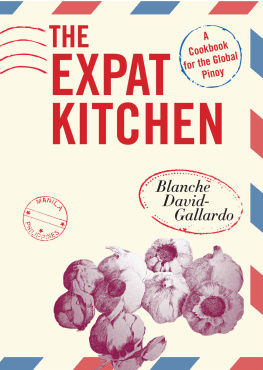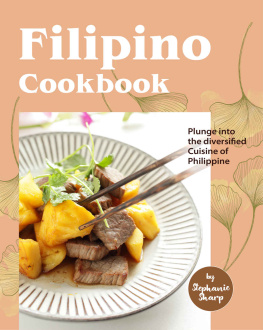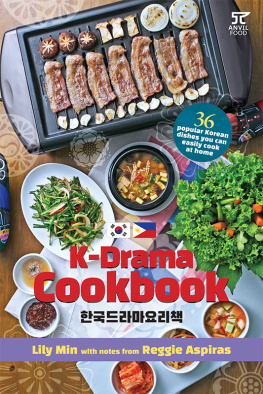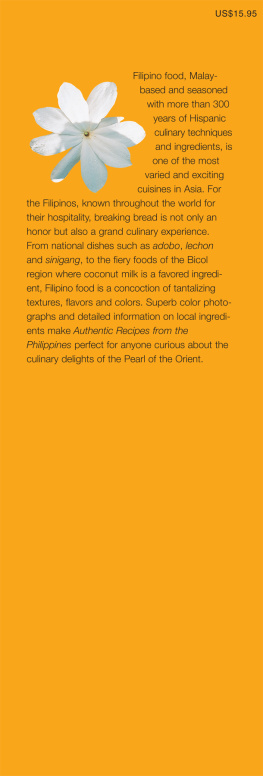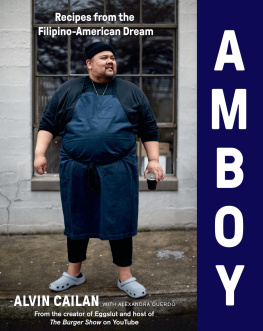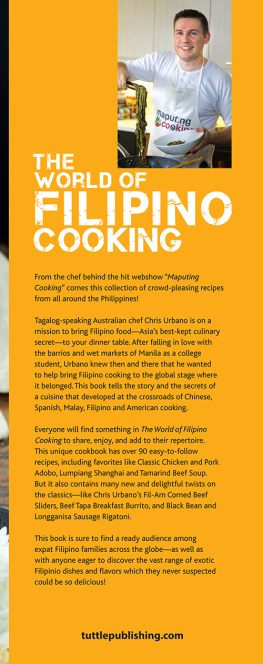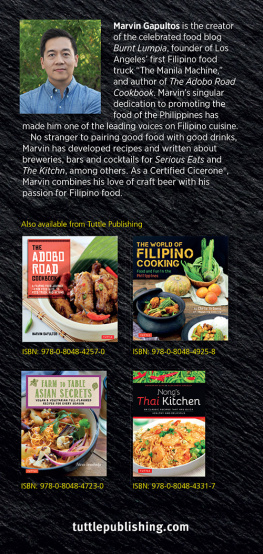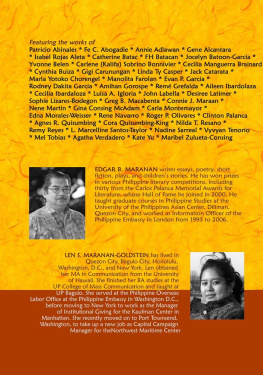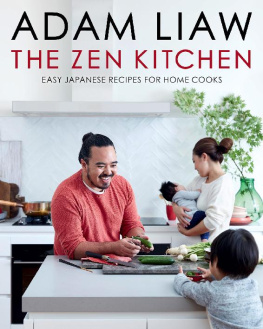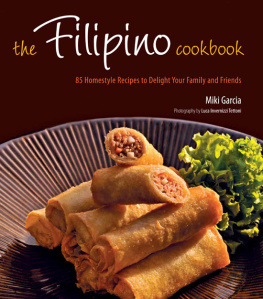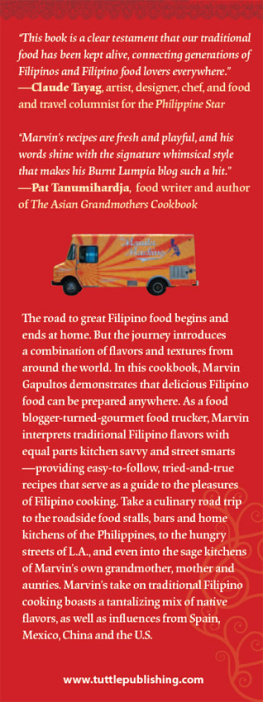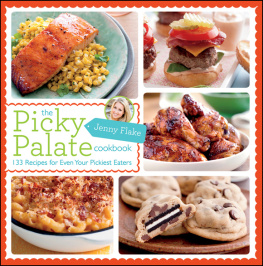THE EXPAT KITCHEN
A COOKBOOK FOR THE GLOBAL PINOY

THE EXPAT KITCHEN
A COOKBOOK FOR THE GLOBAL PINOY

Blanche David-Gallardo
THE EXPAT KITCHEN
A COOKBOOK FOR THE GLOBAL PINOY
by Blanche David-Gallardo
Copyright to this digital edition 2016 by
Blanche David-Gallardo and Anvil Publishing, Inc.
All rights reserved. No part of this book may be reproduced in any form
or by any means without the written permission of the copyright owner
and the publisher.
Published and exclusively distributed by
ANVIL PUBLISHING, INC.
7th Floor Quad Alpha Centrum
125 Pioneer Street, Mandaluyong City
1550 Philippines
Trunk Lines: (+632) 477-4752, 477-4755 to 57
Sales and Marketing:
Fax No.: (+632) 747-1622
www.anvilpublishing.com
Cover and inside illustrations by Bert Gallardo and Miguel Ige
Gallardo
Book design by Jordan Santos (cover) and Soc Orlina (interior)
E-book formatting by Arvyn Cerezo
ISBN 9786214200740 (e-book)
Version 1.0.1
For my late husband,
Bert Gallardo,
my first cooking mentor, who put up with my bungling in the kitchen, while
putting me through my paces until I learned to cook, take over the kitchen,
and send him into happy exile to the living room except when he was cooking
dinuguan (his specialty), which I never learned to cookhence its absence from
this volume.
For my children,
Robi and Cara,
my first guinea-pigs-cum-cheering-squad;
and my grandchildren,
Gabe and Mika,
who, when they were about seven and five, respectively, declared my sukiyaki,
the first time I served it to them, to be Super Yaki!
Contents

CHAPTER 1
Filipino Food 101 and Beyond
Breakfast Faves
Fiesta Faves
Special Occasion Faves
Day-to-Day Faves
Soupy Faves
Traditional Philippine Breads
Snacks
Philippine Desserts
More than Kakanin
CHAPTER 2
Chinoiserie
Chinese Homecooking Dishes
Kung Hei Fat Choi Specials
CHAPTER 3
Spice Rocks: Flavors from our Neighbors
South and Southeast Asian Dishes
Indonesian Rijsttafel
Taste of Vietnam
Snacks, Breads and Sweets
Spice Notes
CHAPTER 4
Private Files
Cara and Her Fusebox
Goodies from the GLGS
Hot Stuff from an Instinctive Cook
The Matriarch of Canlubang
Maritas Kitchen Specials
No Frills She Calls It
CHAPTER 5
Palate Pleasers: Soup to Nuts
Beef
Chicken
Duck
Lamb/Mutton
Pork
Fish and Shellfish
Crabs
Prawns
Salads and Veggies
Sugar Fix
Etcetera, Etcetera: Sauces, Dips and Nibbles
Style Bocuse

I t must be the gypsy in my soul, the Pampango in my blood, but whod have thoughtwhen I was a young bride mincing garlic and chopping onions as a breathing, living kitchen aide to my then more kitchen-savvy husband (who did the cooking for us)that I would one day learn to cook, let alone write a cookbook? Not that I was disinterested in food. As a teenager, I enjoyed whipping up desserts. But my one attempt at cooking was a dismal failure, a fiasco that left me mortified, if not outright traumatized. I had invited my then boyfriend (later, husband) to breakfast, planning to serve potato omelet. I diced the potatoes as I had seen done countless times in the past, but how was I to know they were meant to be pre-cooked before being folded into the beaten eggs in the frying pan? I might never have lived down the occasion, were it not for the events that followed, which subsequently brought us to Hong Kong, and me, to a comfortable familiarity with some of the most interesting home-cooked meals from virtually around the world, particularly from Asia.
At the onset of the sixties, plans for the first-ever regional Sunday supplementThe Asia Magazinewere coming together and recruitment began in earnest for editorial, advertising, marketing, and support staff. These trickled, over the early weeks and months of 1961, into the then British crown colony of Hong Kong, to take up various positions in the magazine. We were a motley group, as different as chalk and cheese, a stew of various nationalities, skin color, political stripes, and religious persuasions. A Little United Nations made up of Filipinos, Indonesians, Japanese, Taiwanese, Indians, Cambodians, Sri Lankans (then called Ceylonese), Americans, Canadians, English, Irish, Portuguese, not to mention Hong Kong Chinese, a category which could be further subdivided into Cantonese, Shanghainese, and Macanese.
My husband Bert and I were recruited, interviewed, and hired in Manila by the publisher, Adrian Zecha, better known today for his other brainchildthe Aman Resorts, a multinational group of very exclusive, very high-end hideaways for the rich and famous. We flew to Hong Kong in mid-February of 1961 on board a prop-jet Philippine Airlines flight which took around three, or more, hours to traverse the short distance. We were quite literally babes in the woods on our first trip out of the country, with two battered and borrowed old suitcases, and US$20 between us. I had on a short overcoat which was gifted by a friend; my husband wore a summer-weight business suit. Our first purchase was for a woolen sweater to keep him warm, and our first meal on our own was at a little Russian bakery/restaurant in Tsim Sha Tsui whose name I can no longer recall.
Hong Kong at the beginning of the sixties was a village. The old Kai Tak Airport was a little more than a huddle of Quonset huts left over from World War II. The only link between the Kowloon peninsula and Victoria (or Hong Kong) island were the Star and Vehicular ferries, both of which ceased operations around midnight, daily, and stopped running altogether when Typhoon Signal No. 8 is hoisted. When the ferries ceased operations, the slack is taken up by a frail covered craft known as the walah-walah and/or sampan, which plied the harbor after hours, manned by pajama-clad boat women. The harbor reclamation, which was to extend the Victoria shoreline to where it is today had not yet begun, and the Star Ferry lay where the Mandarin Hotel now stands. Until recently the best vantage point from which to cross between Hong Kong and Kowloon was the Star Ferry from its location in Central, just past the Hong Kong City Hall. This nostalgic Hong Kong landmark has regrettably been relocated to a more distant reclaimed area near the towering new IFC Centrenot nearly as accessible as the old siterobbing it of its idyllic and convenient former location, romanticized in a number of memorable films.
In Wanchai of the Sixties and Seventies, Susie Wong was a palpable presence among the girlie bars and teahouses boasting topless bar girls whose names were listed on the menus in place of potables or comestibles. Up on Conduit Road in the Mid-Levels, the celebrated setting of the hospital scene in the popular Hollywood film

